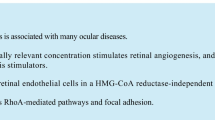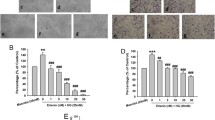Abstract
Background
While statins have an anti-angiogenic property, their underlying mechanisms are not fully understood. We investigated intracellular mechanisms of simvastatin-mediated reduction in VEGF-induced signalings.
Methods
The effects of simvastatin on cell proliferation and viability were evaluated by [3H]-thymidine incorporation in retinal endothelial cells (RECs) and cell counting. The impact of simvastatin on VEGF-induced phosphorylation of p44/42 mitogen-activated protein (MAP) kinase, myosin light chain (MLC), and VEGF-receptor (VEGFR) 2 were examined by Western blotting. Involvement of the mevalonate pathway in VEGF-induced signaling was also examined.
Results
Simvastatin (1 and 10 µM) suppressed VEGF-induced RECs proliferation in a concentration-dependent manner, without affecting cell viability. Simvastatin significantly inhibited VEGF-induced phosphorylation of VEGFR2 and its downstream mediators, p44/42 MAP kinase and MLC. Mevalonate completely reversed VEGF-induced VEGFR2 phosphorylation, but only partially reversed the phosphorylation of p44/42 MAP kinase and MLC.
Conclusion
These data indicate that simvastatin exerts its anti-angiogenic effects through the reduction of VEGFR2 phosphorylation in RECs at least in part. However, there seems to be both mevalonate-dependent and independent pathway in simvastatin’s anti-angiogenic property.





Similar content being viewed by others
References
Molgaard J, von Schenck H, Olsson AG (1988) Effects of simvastatin on plasma lipid, lipoprotein and apolipoprotein concentrations in hypercholesterolaemia. Eur Heart J 9:541–551
Graaf MR, Richel DJ, van Noorden CJ, Guchelaar HJ (2004) Effects of statins and farnesyltransferase inhibitors on the development and progression of cancer. Cancer Treat Rev 30:609–641
Buhaescu I, Izzedine H (2007) Mevalonate pathway: a review of clinical and therapeutical implications. Clin Biochem 40:575–584
MRC/BHF Heart Protection Study of cholesterol lowering with simvastatin in 20,536 high-risk individuals: a randomised placebo-controlled trial. (2002) Lancet 360:7–22
Coons JC (2002) Hydroxymethylglutaryl-coenzyme A reductase inhibitors in osteoporosis management. Ann Pharmacother 36:326–330
Campbell MJ, Esserman LJ, Zhou Y, Shoemaker M, Lobo M, Borman E, Baehner F, Kumar AS, Adduci K, Marx C, Petricoin EF, Liotta LA, Winters M, Benz S, Benz CC (2006) Breast cancer growth prevention by statins. Cancer Res 66:8707–8714
Matar P, Rozados VR, Binda MM, Roggero EA, Bonfil RD, Scharovsky OG (1999) Inhibitory effect of Lovastatin on spontaneous metastases derived from a rat lymphoma. Clin Exp Metastasis 17:19–25
Vincent L, Soria C, Mirshahi F, Opolon P, Mishal Z, Vannier JP, Soria J, Hong L (2002) Cerivastatin, an inhibitor of 3-hydroxy-3-methylglutaryl coenzyme a reductase, inhibits endothelial cell proliferation induced by angiogenic factors in vitro and angiogenesis in in vivo models. Arterioscler Thromb Vasc Biol 22(4):623–629
Park HJ, Kong D, Iruela-Arispe L, Begley U, Tang D, Galper JB (2002) 3-hydroxy-3-methylglutaryl coenzyme A reductase inhibitors interfere with angiogenesis by inhibiting the geranylgeranylation of RhoA. Circ Res 91:143–150
Gingras D, Lamy S, Beliveau R (2000) Tyrosine phosphorylation of the vascular endothelial-growth-factor receptor-2 (VEGFR-2) is modulated by Rho proteins. Biochem J 348(Pt 2):273–280
Park HJ, Zhang Y, Georgescu SP, Johnson KL, Kong D, Galper JB (2006) Human umbilical vein endothelial cells and human dermal microvascular endothelial cells offer new insights into the relationship between lipid metabolism and angiogenesis. Stem Cell Rev 2:93–102
Nakagawa K, Chen YX, Ishibashi H, Yonemitsu Y, Murata T, Hata Y, Nakashima Y, Sueishi K (2000) Angiogenesis and its regulation: roles of vascular endothelial cell growth factor. Semin Thromb Hemost 26:61–66
Hata Y, Nakagawa K, Ishibashi T, Inomata H, Ueno H, Sueishi K (1995) Hypoxia-induced expression of vascular endothelial growth factor by retinal glial cells promotes in vitro angiogenesis. Virchows Arch 426:479–486
Andreoli CM, Miller JW (2007) Anti-vascular endothelial growth factor therapy for ocular neovascular disease. Curr Opin Ophthalmol 18:502–508
Noda Y, Hata Y, Hisatomi T, Nakamura Y, Hirayama K, Miura M, Nakao S, Fujisawa K, Sakamoto T, Ishibashi T (2004) Functional properties of hyalocytes under PDGF-rich conditions. Invest Ophthalmol Vis Sci 45:2107–2114
Kawahara S, Hata Y, Miura M, Kita T, Sengoku A, Nakao S, Mochizuki Y, Enaida H, Ueno A, Hafezi-Moghadam A, Ishibashi T (2007) Intracellular events in retinal glial cells exposed to ICG and BBG. Invest Ophthalmol Vis Sci 48:4426–4432
Kureishi Y, Luo Z, Shiojima I, Bialik A, Fulton D, Lefer DJ, Sessa WC, Walsh K (2000) The HMG-CoA reductase inhibitor simvastatin activates the protein kinase Akt and promotes angiogenesis in normocholesterolemic animals. Nat Med 6:1004–1010
Weis M, Heeschen C, Glassford AJ, Cooke JP (2002) Statins have biphasic effects on angiogenesis. Circulation 105:739–745
Chen J, Zhang ZG, Li Y, Wang Y, Wang L, Jiang H, Zhang C, Lu M, Katakowski M, Feldkamp CS, Chopp M (2003) Statins induce angiogenesis, neurogenesis, and synaptogenesis after stroke. Ann Neurol 53:743–751
Medina RJ, O’Neill CL, Devine AB, Gardiner TA, Stitt AW (2008) The pleiotropic effects of simvastatin on retinal microvascular endothelium has important implications for ischaemic retinopathies. PLoS ONE 3:e2584
Kawahara S, Hata Y, Kita T, Arita R, Miura M, Nakao S, Mochizuki Y, Enaida H, Kagimoto T, Goto Y, Hafezi-Moghadam A, Ishibashi T (2008) Potent inhibition of cicatricial contraction in proliferative vitreoretinal diseases by statins. Diabetes 57:2784–2793
Kiosses WB, Daniels RH, Otey C, Bokoch GM, Schwartz MA (1999) A role for p21-activated kinase in endothelial cell migration. J Cell Biol 147:831–844
Hata Y, Miura M, Nakao S, Kawahara S, Kita T, Ishibashi T (2008) Antiangiogenic properties of fasudil, a potent Rho-kinase inhibitor. Jpn J Ophthalmol 52:16–23
Soker S, Takashima S, Miao HQ, Neufeld G, Klagsbrun M (1998) Neuropilin-1 is expressed by endothelial and tumor cells as an isoform-specific receptor for vascular endothelial growth factor. Cell 92:735–745
Acknowledgments
We acknowledge David Goodman (Pharmascience), Waichiro Katsuda, Tomoko Saeki, and Noriyuki Yoshida (Aqumen Biopharmaceuticals, K.K.) for their excellent help. The study was supported in part by grants from the Ministry of Education, Science, Sports and Culture, Japan (Grant-in-Aid for Scientific Research #21592233).
Author information
Authors and Affiliations
Corresponding author
Rights and permissions
About this article
Cite this article
Hata, Y., Miura, M., Asato, R. et al. Antiangiogenic mechanisms of simvastatin in retinal endothelial cells. Graefes Arch Clin Exp Ophthalmol 248, 667–673 (2010). https://doi.org/10.1007/s00417-009-1282-4
Received:
Revised:
Accepted:
Published:
Issue Date:
DOI: https://doi.org/10.1007/s00417-009-1282-4




